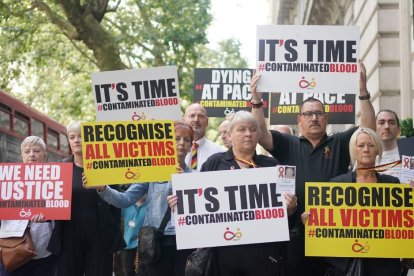United Kingdom: Report reveals the National Health Services' "catalog of failures" in contaminated blood cases
Between the 1970s and 1980s, thousands of people died after contracting HIV and hepatitis from blood transfusions.

(Cordon Press)
A report published this Monday revealed the "catalog of failures" made by the United Kingdom and its medical professionals that caused 30,000 citizens to become infected with deadly diseases and 3,000 of them to die after undergoing contaminated blood transfusions in the 1970s and 1980s. The victims were infected with the human immunodeficiency virus (HIV) and hepatitis. Media outlets such as the BBC defined this case as "the biggest treatment disaster in the history of the National Health Service (NHS)."
"It will be astonishing to anyone who reads this report that these events could have happened in the UK. It may also be surprising that the questions why so many deaths and infections occurred have not had answers before now," said Sir Brian Langstaff, who has chaired the investigation since February 2018. "All the evidence points to the inescapable conclusion that children and adults were not treated in a manner that prioritized their safety above other considerations."
To reach this conclusion, Sir Brian Langstaff, along with lawyers and public officials involved in the investigation launched during former Prime Minister Theresa May's administration, examined millions of documents and heard the testimonies of dozens of witnesses.
One of those witnesses was Jason Evans, who lost his father in 1993 to HIV and hepatitis after receiving a contaminated blood transfusion. "This whole scandal has blanketed my entire life. My dad knew he was dying and he took many home videos, which I've got and replayed over and over again growing up because that's really all I had," he said.
The British government will respond
The evidence presented by the researchers in the report led the British government to make an immediate statement. In statements collected on local radio LBC, John Glen, spokesman for Rishi Sunak's administration, said that "if there is clear evidence and there is a way to do so," they will address the matter to "do justice" to those affected. Glen has served as a liaison between investigators and the British government.
At the end of 2022, the Sunak administration began to compensate each of the survivors and some of the victims' spouses with £100,000 (about $127,000).
The case of infected blood in the United Kingdom
This scandal dates back to the mid-1970s when the United Kingdom began to have trouble meeting the demand to treat people whose blood did not clot properly (such as hemophilia), so it decided to import supplies from the United States.
At that time, a new type of factor VIII had been developed, thanks to the combination of plasma from tens of thousands of donors. This is precisely where the problem began. It turns out that a good part of the donors were high-risk, such as inmates and drug users, which increased the chances of contaminating everything. If even one person who donated blood was contaminated with a disease, the entire batch would be affected.
The mixture produced entire batches of products to replace Factor VIII and IX that were contaminated with deadly viruses, such as Hepatitis C and HIV.
As a result, although the total number of infected people is not known for certain, due in part to the fact that the symptoms can take years to appear, it is estimated that around 30,000 people were affected by these contaminated batches. Of these, some 3,000 people have already died as a result.
RECOMMENDATION





















